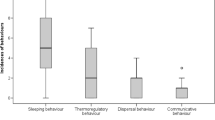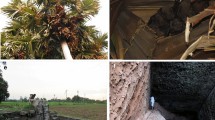Abstract
The emergence behaviour of the Indian flying fox, Pteropus giganteus in response to different seasons and environmental conditions was studied in an age-old colony located at Mohanlal Ganj, Uttar Pradesh, India. The bats were chosen large, tall and well exposed Eucalyptus sp. trees as their roost. The behavioural activities such as wing stretching, shifting of roost to the periphery, vocalization and circling flights around the roosts were initiated by a few individuals before their emergence. The average bat emergence was observed 0:32 ± 0:10 h:min after the sunset and varied over seasons. The time of bat emergence was significantly influenced by the day length (r = 0.889), sunset (r = 0.952) and the ambient temperature delayed the time of emergence (r = 0.886). The duration of emergence was relatively short during winter compared to summer and monsoon seasons. Therefore, the present study revealed that the emergence time of P. giganteus was significantly influenced by the sunset, day length, and temperature.





Similar content being viewed by others
References
Ali, A. 2010. Population trend and conservation status of Indian flying fox Pteropus giganteus Brunnich, 1782 (Chiroptera: Pteropodidae) in Western Assam. The Ecoscan 4: 311–312.
Aryal, A., D. Brunton, and D. Raubenheimer. 2014. Impacts of climate change on human-wildlife-ecosystem interactions in the Trans-Himalayan region of Nepal. Theoretical and Applied Climatology 115: 517–529.
Aryal, A., S.C.P. Coogan, W. Ji, J.M. Rothman, and D. Raubenheimer. 2015. Foods, macronutrients and fibre in the diet of blue sheep (Psuedois nayaur) in the Annapurna Conservation Area of Nepal. Ecology and Evolution 5: 4006–4017.
Aryal, A., U.B. Shrestha, W. Ji, S. Ale, T. Ingty, T. Maraseni, G. Cockfield, and D. Raubenheimer. 2016. Predicting the distributions of predator (snow leopard) and prey (blue sheep) with climate change in the Himalaya. Ecology and Evolution 6: 4065–4075.
Barclay, R.M. 1985. Long-versus short-range foraging strategies of hoary (Lasiurus cinereus) and silver-haired (Lasionycteris noctivagans) bats and the consequences for prey selection. Canadian Journal of Zoology 63: 2507–2515.
Barlow, K. 1999. Expedition Field Techniques. Bats. Londra: The Expedition Advisory Centre, Royal Geographical Society.
Connell, K.A., U. Munro, and F.R. Torpy. 2006. Daytime behaviour of the grey-headed flying fox Pteropus poliocephalus Temminck (Pteropodidae: Megachiroptera) at an autumn/winter roost. Australian Mammalogy 28: 7–14.
Deshpande, K. 2012. Assessing diversity and distribution of bats in relation to land-use and anthropogenic threats in the southern Western Ghats, 30. India: Final Report Submitted to the Rufford Small Grants for Nature Conservation.
Dey, S., U. Roy, and S. Chattopadhyay. 2013. Distribution and abundance of three populations of Indian flying fox (Pteropus giganteus) from Purulia district of West Bengal, India. Taprobanica: The Journal of Asian. Biodiversity 5: 60–66.
Downs, N.C., V. Beaton, J. Guest, J. Polanski, S.L. Robinson, and P.A. Racey. 2003. The effects of illuminating the roost entrance on the emergence behaviour of Pipistrellus pygmaeus. Biological Conservation 111: 247–252.
Duverge, P.L., G. Jones, J. Rydell, and R.D. Ransome. 2000. Functional significance of emergence timing in bats. Ecography 23: 32–40.
Entwistle, A.C., P.A. Racey, and J.R. Speakman. 1996. Habitat exploitation by a gleaning bat, Plecotus auritus. Philosophical Transactions of the Royal Society of London B: Biological Sciences 351: 921–931.
Erkert, H.G. 1982. Ecological aspects of bat activity. In Ecology of bats, ed. T.H. Kunz, 201–242.
Frick, W.F., P.M. Stepanian, J.F. Kelly, K.W. Howard, C.M. Kuster, T.H. Kunz, and P.B. Chilson. 2012. Climate and weather impact timing of emergence of bats. PLoS ONE 7: e42737.
Granek, E. 2002. Conservation of Pteropus livingstonii based on roost site habitat characteristics on Anjouan and Moheli, Comoros islands. Biological Conservation 108: 93–100.
Gulraiz, T.L., A. Javid, M. Mahmood-Ul-Hassan, A. Maqbool, S. Ashraf, M. Hussain, and S. Daud. 2015. Roost characteristics and habitat preferences of Indian flying fox (Pteropus giganteus) in urban areas of Lahore, Pakistan. Turkish Journal of Zoology 39: 388–394.
Hahn, M.B., J.H. Epstein, E.S. Gurley, M.S. Islam, S.P. Luby, P. Daszak, and J.A. Patz. 2014. Roosting behaviour and habitat selection of Pteropus giganteus reveal potential links to Nipah virus epidemiology. Journal of Applied Ecology 51: 376–387.
Heldmaier, G., S. Steinlechner, T. Ruf, H. Wiesinger, and M. Klingenspor. 1989. Photoperiod and thermoregulation in vertebrates: Body temperature rhythms and thermogenic acclimation. Journal of Biological Rhythms 4: 139–153.
Isaac, S.S., and G. Marimuthu. 1993. Early outflying and late homeflying in the Indian pygmy bat under natural conditions. Oecologia 96: 426–430.
Jones, G. 1995. Flight performance, echolocation and foraging behaviour in noctule bats Nyctalus noctula. Journal of Zoology 237: 303–312.
Jones, G., and J. Rydell. 1994. Foraging strategy and predation risk as factors influencing emergence time in echolocating bats. Philosophical Transactions of the Royal Society of London B: Biological Sciences 346: 445–455.
Kasso, M., and M. Balakrishnan. 2013. Ecological and economic importance of bats (Order Chiroptera). ISRN Biodiversity 2013.
Kumar, R., D.N. Prasad, and V. Elangovan. 2017. An update on distribution of the Indian Flying Fox, Pteropus giganteus in Uttar Pradesh, India. Trends in Biosciences 10(37): 7794–7801.
Kunz, T.H., E. Braun de Torrez, D. Bauer, T. Lobova, and T.H. Fleming. 2011. Ecosystem services provided by bats. Annals of the New York Academy of Sciences 1223: 1–38.
Lee, Y.F., and G.F. McCracken. 2001. Timing and variation in the emergence and return of Mexican free-tailed bats, Tadarida brasiliensis mexicana. Zoological Studies 40: 309e316.
Leverett, B. and D. Bertolette. 2015. Measuring guidelines handbook. American Forest. american forests. org/wp-content/uploads/2014/12/AF-Tree-Measuring-Guidelines_LR.
Manandhar, S., S. Thapa, T.K. Shrestha, R. Jyakhwo, W. Wright, and A. Aryal. 2017. Population status and diurnal behaviour of the Indian flying fox Pteropus giganteus (brünnich, 1782) in Kathmandu valley, Nepal. Proceedings of the Zoological Society. https://doi.org/10.1007/s12595-017-0219-x.
Maruthupandian, J., and G. Marimuthu. 2013. Cunnilingus apparently increases duration of copulation in the Indian flying fox, Pteropus giganteus. PLoS ONE 8: e59743.
Mathur, V., Y.S. Priya, H. Kumar, M. Kumar, and V. Elangovan. 2012. Reproductive behavior and population dynamics of the Indian flying fox, Pteropus giganteus. Journal of Threatened Taxa 4: 2699–2704.
McWilliam, A.N. 1989. Emergence behaviour of the bat Tadarida (Chaerephon) pumila (Chiroptera: Molossidae) in Ghana, West Africa. Journal of Zoology 219: 698–701.
Molur, S., C. Srinivasulu, P. Bates, and C. Francis. 2008. Pteropus giganteus. The IUCN Red List of Threatened Species.
Ochoa-Acuna, H., and T.H. Kunz. 1999. Thermoregulatory behavior in the small Island flying fox, Pteropus hypomelanus (Chiroptera: Pteropodidae). Journal of Thermal Biology 24: 15–20.
Panthi, S., S.C.P. Coogan, A. Aryal, and D. Raubenheimer. 2015. Diet and nutrient balance of red panda in Nepal. The Science of Nature (Naturwissenschaften) 102(9–10): 1–4.
Sauter, A., P. Korner, W. Fiedler, and L. Jenni. 2012. Individual behavioural variability of an ecological generalist: activity patterns and local movements of Mallards Anas platyrhynchos in winter. Journal of Thermal Biology 153: 713–726.
Senthilkumar, K., and G. Marimuthu. 2012. Tree roosting fruit bat (Chiroptera: Pteropodidae) in southern Tamil Nadu. International Journal of Applied Bioresearch 14: 4–10.
Simmons, N.B. 2005. Order Chiroptera. In Mammal Species of the World: a Taxonomic and Geographic Reference 3rd edition, vol. 1, ed. D.E. Wilson and D.M. Reeder, 312–529. Baltimore Maryland: Johns Hopkins University Press.
Su, J., A. Aryal, Z. Nan, and W. Ji. 2015. Climate change-induced range expansion of a subterranean rodent: Implications for rangeland management in Qinghai-Tibetan Plateau. PLoS ONE 10: e0138969.
Sudhakaran, M., D. Swamidoss, and P. Parvathiraj. 2012. Emergence and returning activity in the Indian Flying fox, Pteropus giganteus (Chiroptera: Pteropodidae). International Journal of Geography and Geology 1: 1–9.
Sugita, N. 2016. Homosexual Fellatio: Erect Penis Licking between Male Bonin Flying Foxes Pteropus pselaphon. PLoS ONE 11: e0166024.
Tidemann, C.R., and J.E. Nelson. 2004. Long-distance movements of the grey-headed flying fox (Pteropus poliocephalus). Journal of Zoology 263: 141–146.
Venkatesan, A. 2007. Status of the Indian Flying Fox (Pteropus giganteus) in Bengaluru. BAT NETCCINSA Newsletter 8: 13–15.
Welbergen, J.A. 2006. Timing of the evening emergence from day roosts of the grey-headed flying fox, Pteropus poliocephalus: The effects of predation risk, foraging needs, and social context. Behavioral Ecology and Sociobiology 60: 311.
Welbergen, J.A. 2008. Variation in twilight predicts the duration of the evening emergence of fruit bats from a mixed-species roost. Animal Behaviour 75: 1543–1550.
Willis, C.K., and R.M. Brigham. 2004. Roost switching, roost sharing, and social cohesion: Forest-dwelling big brown bats, Eptesicus fuscus, conform to the fission fusion model. Animal Behaviour 68: 495–505.
Acknowledgements
We thank the financial assistance of the University Grants Commission, New Delhi, and Uttar Pradesh State Biodiversity Board, Uttar Pradesh through research projects (UGC No. 42-530/2013(SR); UPSBB No: 493/3-4-48/2013) to VE and UGC Fellowship to RK.
Author information
Authors and Affiliations
Corresponding author
Rights and permissions
About this article
Cite this article
Kumar, R., Prasad, D.N. & Elangovan, V. The Effect of Seasonal Changes on Emergence Behaviour of the Indian Flying Fox, Pteropus giganteus. Proc Zool Soc 72, 74–78 (2019). https://doi.org/10.1007/s12595-018-0269-8
Received:
Accepted:
Published:
Issue Date:
DOI: https://doi.org/10.1007/s12595-018-0269-8




